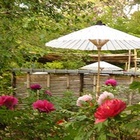Mari had no children and, after her husband died early, she focused solely on work.
After graduating from a vocational school, she worked as an elementary school teacher while finishing university. She met her husband at university, who shared the same aspirations as Mari: "I want many children to know the joy of studying." After the two got married, Mari taught mathematics at a junior high school in a neighboring town while helping out at the cram school her husband ran.
Eleven years later, her husband died in a traffic accident. Mari wondered if she would be able to teach her children on her own.
When she hesitated to continue as a teacher, her mother encouraged her, saying, "What are you talking about? You've loved reading books since you were little, and you used to gather the neighborhood kids together to play 'school'. Now you're an adult, and this is no time to be whining about it." Her father also supported her.
Having regained her confidence, Mari noticed something while continuing her teaching career: when asked "What is the most difficult subject?", her students would unanimously answer "Math and Japanese."
So Mari decided to study Portuguese more, and went back to university to major in Portuguese language and Brazilian literature. After graduating, she moved to São Paulo and spent her days busy teaching Portuguese at a private junior high school and mathematics at a public high school.
Mari started working at the age of 18, but retired early at the age of 44. She began to think, "So, what should I do with my second life?" While walking around Toyo-gai, an elderly Japanese man handed her a flyer. It was a job advertisement for a bento, pasta, udon, and soba factory in Joso City, Ibaraki Prefecture.
Mari looked over the flyer with interest several times. "I've never thought about it, but maybe I could do it. When I worked at a school in the neighboring town, I often made bento lunches, and my colleagues would look at my tamagoyaki and omusubi with curiosity."
After that, I did some research and seriously considered going to Japan to work. My friends were very surprised. "Why?! You're alone, so you're free, right? It's fine if you're just going to Japan for fun, but what about working in Japan?"
But Mari was determined. Having never been to Japan, she saw it as a second challenge in her life.
I arrived in Japan on April 1, 2015. It was cherry blossom season when I saw Japan for the first time, and it felt like I was in a dream. Two days later, I started working at the factory. My colleagues were Japanese Brazilians and people from the Philippines, and they all worked hard.
Mari lived with two Japanese-Brazilian women in an old apartment near the factory and gradually got used to her new life.
During the long holiday in May, a Brazilian couple living next door couldn't take time off, so they asked Mari to look after their three children. Mari gladly accepted and spent the holiday with her children. Then she discovered something unexpected: there was a Brazilian school in Japan! The three children were in nursery school, first grade, and third grade. The lessons were in Portuguese, and the subjects were the same as in Brazilian schools. Therefore, the children couldn't speak Japanese even though they were in Japan.
On September 10, 2015, Mari finished work at 4:30 p.m. and walked to her apartment. It had been raining heavily for two days, and the water was up to her knees that day. She saw a large group of people walking quickly to the south. Then, someone pulled Mari's hand. It was Joy, a Filipina who lived in the same apartment. She yelled to Mari, "We have to hurry to the evacuation center." Joy was also on her way to the evacuation center with her wife, who was holding a baby, and her two children.
In the school gymnasium that was being used as an evacuation centre, many residents were sitting on thin blankets watching the news on TV or lying down looking tired.
The Kinugawa River, which runs through Ibaraki Prefecture, overflowed, and Joso City was engulfed in floodwaters. Buildings, fields, and other structures were submerged, and about one-third of the city was flooded. More than 2,600 residents evacuated to schools and community centers.
Mari was surprised. It was the same footage she had seen in Brazil in 2011 of the Great East Japan Earthquake. This time it wasn't on TV, it was the scenery right in front of her eyes. "Japan is in big trouble! Natural disasters like earthquakes, typhoons and tsunamis strike suddenly."
At the evacuation center, Mari gratefully accepted the food handed out by volunteers.
Although she had heard that the bento factory would reopen someday, Mari felt sorry for the owner and his co-workers who had lost everything, but she longed to return to Brazil, to see the smiling faces of her parents and friends there, victims of this terrible disaster.
"I want to come back to Japan again. I want to teach dekasegi children at a Brazilian school." With this thought in mind, he returned to Brazil a month later.
© 2019 Laura Honda-Hasegawa




